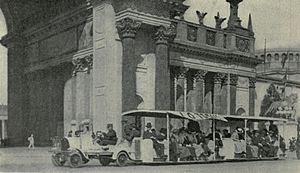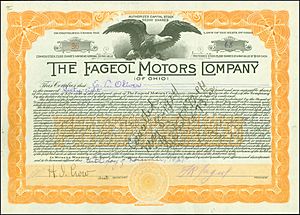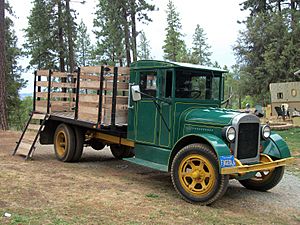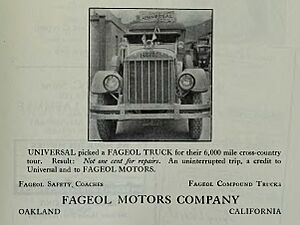Fageol facts for kids

Fageol Motors was an American company that made different kinds of vehicles. They built buses, trucks, and even farm tractors.
Contents
History of Fageol Motors
Fageol Motors started in 1916 in Oakland, California. Four brothers, Rollie, William, Frank, and Claude Fageol, founded the company. Their goal was to build trucks, farm tractors, and cars. Their factory was right next to a Chevrolet factory, which later became part of General Motors.
Fageol tried to make two fancy cars, but they stopped production. This happened because the special engines they used were needed for airplanes during World War I.
The first Fageol farm tractor was actually a redesigned Hamilton Walking Tractor. It was changed to work better for farms on the West Coast. Around 1923, the tractor part of the business was sold to another company called Great Western Motors.
In 1921, Fageol was the first company to build a bus from scratch. They called this new bus the "Safety Bus." It was designed to be very stable and not tip over easily when turning corners. It was also lower to the ground, making it easier for people to get on and off. Later, these buses were called "Safety Coaches."
Fageol trucks became very popular. They had a special gearbox that allowed them to carry heavy loads slowly or drive fast on highways with lighter loads. You could easily spot these trucks because they had a big number "7" painted on the front.
The Fageol brothers left the company in 1927. They started a new company called Twin Coach Company, which made buses in Ohio. During the Great Depression, Fageol Motors faced financial problems. A bank took over and renamed the company Fageol Truck and Coach. In 1938, a man named T. A. Peterman bought the factory. The very first Peterbilt truck was made there in 1939.
The South Australian Railways used several Fageol buses. In 1932, they turned four of these road buses into railcars. These railcars ran on train tracks, but they were not designed for it, so the ride was very bumpy. The last Fageol railcar was taken out of service in 1961.
Products Made by Fageol
Fageol made tractors, buses, and trucks. They also built at least three luxury cars and engines for vehicles and ships. The company changed its name and location several times. Some of its names included Fageol Motors Company and Fageol Truck and Coach Company.
Tractors and the Trackless Train
The Fageol brothers first tried selling a tractor called the Hamilton Walking Tractor, which they rebranded. It wasn't very successful. However, they got a special job for the 1915 Panama–Pacific International Exposition in San Francisco. This fair was huge, covering over 600 acres, and millions of people visited it.
The brothers came up with a solution: the Fageol Auto Train, also known as the Trackless Train. It was powered by a Ford engine and pulled two or three open-sided cars, each carrying 20 passengers. This train helped people get around the large fairgrounds. This success led to the founding of the Fageol Motors Company.
Trucks Built by Fageol
In 1950, the company made a unique truck called the TC CargoLiner. It was advertised as "A Trailer Without A Tractor." In 1953, the Twin Coach Company received a patent for a design that became standard for many trucks. Fageol produced trucks of various sizes, from 1.5 tons to 6 tons.
Cars Made by Fageol
From the beginning, Fageol Motors planned to build cars. Frank R. and William B. Fageol, along with Louis H. Bill, built and sold what was meant to be a very expensive luxury car. It used a special aircraft engine. Only three of these "Fageol Four Passenger Touring Speedsters" were made. Production stopped when the government took over the engine factory to build engines for war planes.
Other cars built by the company included:
- Fageol 100
- Fageol Supersonic
- PataRay (also known as Fageol Special)
Buses Made by Fageol
Fageol continued to make buses until 1953. At that time, the bus-making part of the Fageol Twin Coach Company was taken over by another company called Flxible.
Some of the buses Fageol produced were:
- Twin Coach 44S (made with other companies)
- Safety Coach
- Cruising coach called "America"
- Canopy-covered double-decker "Sight-Seeing" bus
- Fageol Flyer
- Parlor Car
- Rear double-decker Parlor Car
- Super Twin (introduced in 1938) – This was a very large, 14-ton, 58-passenger diesel-electric bus that was hinged in the middle.
See also
 In Spanish: Fageol para niños
In Spanish: Fageol para niños




